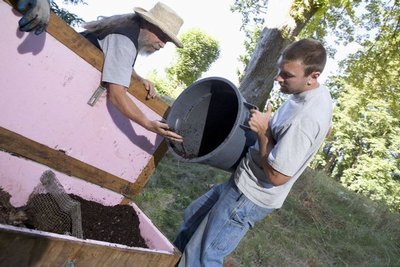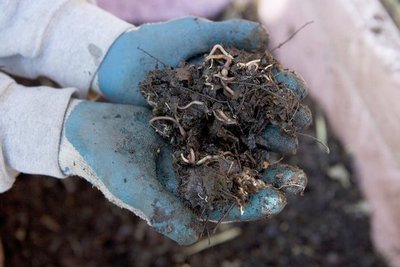August 16, 2007
Worms crawl in and out at UW Bothell
They’re wrangling Red Wrigglers — try saying that three times — at UW Bothell these days. And what those compost-friendly worms leave behind enriches the herbicide-free campus environment.
Why worms? Tony Guerrero, director of facilities services for the branch campus and its companion, Cascadia Community College, said he got interested in vermicomposting — using worms to break down compost — back in about 1989, when he was maintenance supervisor for the Kingdome.
In that job he saw a lot of “pre-consumer” waste generated during the preparation of meals and thought it a shame. His interest piqued, Guerrero read the popular book Worms Eat My Garbage by Mary Applehof.
Convinced, he bought some Red Wrigglers, a type of worm well known for its composting capabilities — and before long had four or five vermicomposting bins going full-time at the Kingdome.
Worms such as these can eat their own body weight in organic material each day, and leave behind residue called castings — OK, worm poop — rich in nitrogen, potassium and phosphorous.
Noticing similar food waste in his own habits, Guerrero made worm composting a family project. “I had to convince my wife it wouldn’t stink … and that if I do this stuff at work I should do it at home,” he said, “Now nothing gets past her.”
Guerrero worked in facilities on the Seattle campus from 2000 to 2003, when he joined UW Bothell. It seemed natural to let the worms crawl into his new job surroundings. “I brought in the first batches of worms from my bins at home in order to start bins here. We built four bins, then eight — now we have 16.”
Guerrero said the custodial staff and grounds crew warmed to the project quickly, and teamed up to make compost tea — a highly concentrated liquid — for use on campus plants. Tyson Kemper, lead gardener for UW Bothell, explained: “The basis is the same as a tea bag in water You put herbs in, a natural substance, and it extracts minerals and nutrients into the water. It’s liquifying the compost, to get its nutritional value.”
Kemper elaborately described the compost. “It’s filled with bacteria and fungi and protozoa and nemotodes and single-celled critters, in every shovelfull of compost.” He said they aerate the compost frequently — toss it around to fluff it with air — and “brew” the tea for a day. What results, he said, is “like a nice, dark cup of coffee out of a French press” that is then applied to plant roots or sprayed on the leaves, “inoculating the surfaces with the good stuff.”
He said the reason they brew the compost tea rather than just add compost to plants is that “during the brewing process all the beneficial bacteria and fungi in the compost are encouraged to reproduce, thus increasing their numbers exponentially in the tea, creating a sort of microbal soup.” Kemper added, “It is this extremely high density of beneficial bacteria and fungi — the good stuff — that will enrich the soil and thus feed the plants.”
Guerrero is an enthusiastic ambassador of UW Bothell’s vermicomposting, offering a Power Point presentation and tours that also highlight the campus’ many green efforts, from wetlands restoration to stormwater systems. If visitors, especially elementary school ones, can’t make it to the campus, Guerrero takes his show — worm bins, that is — on the road. The program even has a cartoon mascot for young children, Tilly the worm. “I hold up Tilly and say, this is what we do here, and the kids just have a ball with it,” he said.
The grounds crew at UW Bothell stopped using herbicides about a year ago, and have sought natural ways to manage plants. Kemper, a somewhat philosophical gardener, said the appoach is working, even if there are a few more weeds around than when chemicals were used. “We’re trying to create an environment where things are self-sustaining and grow to their potential, not to an artificial bar,” he said.



